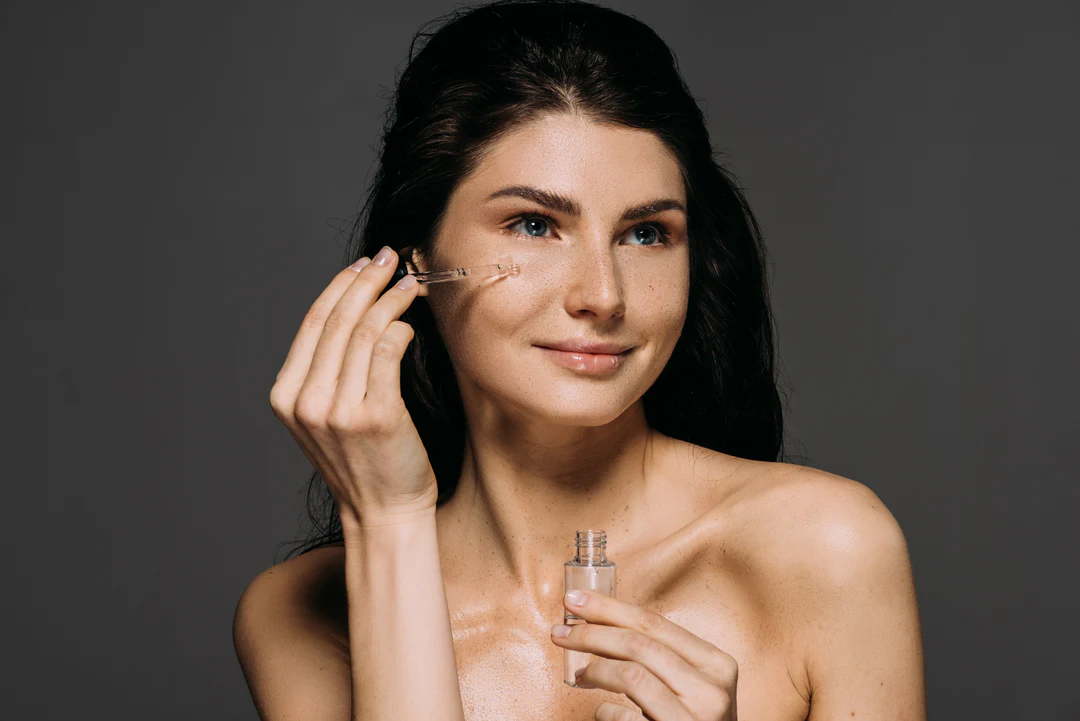What is Niacinamide? And What Benefits Does It Have for Skin Care?
In the world of skin and beauty products, buzzwords are popping up all the time, with a new “it” ingredient popping up in nearly every product on the market. Niacinamide, a form of vitamin B3, is one of those ingredients. Like many trendy ingredients, it has a long history in the professional beauty world and has been used in dermatology practices for decades.
It’s certainly reassuring to know that the pros are fans of Niacinamide, but you can’t blame them if you don’t really know what Niacinamide is. Or what benefits it has for your skin. That’s why we’re here to clear things up.
What is Niacinamide?
Also known as niacinamide, Niacinamide is a form of vitamin B3 that’s scientifically proven to help treat acne, rosacea and pigmentation issues, as well as signs of aging like wrinkles. Your skin constantly needs Niacinamide to stay healthy, but it can’t produce the ingredient naturally. Taking a supplement or applying it topically to your skin with a Niacinamide-rich skincare product will ensure long-lasting, healthy, happy skin for all skin types and ages.
What Benefits Does Niacinamide Have for Skin?
It would be easier to list the skin care benefits that Niacinamide does not offer. It’s no wonder that the popularity of this ingredient in the industry continues unabated among experts and beauty enthusiasts. Here are some of the benefits that you can expect from using Niacinamide.
Benefits of Niacinamide for Skin:
Niacinamide protects the skin from environmental damage
Niacinamide supports collagen production
Niacinamide supports the production of hyaluronic acid that occurs naturally in the skin
Niacinamide improves skin hydration
Niacinamide reduces signs of aging like fine lines and wrinkles
Niacinamide fights acne and breakouts
Niacinamide shrinks enlarged pores
Niacinamide can help lighten pigmented areas of the skin
Pretty impressive, don’t you think? Niacinamide is a master of skin multitasking and can be used as a standalone ingredient in your skin care routine, but is also very compatible with other active ingredients and can be easily incorporated into your routine without worrying about irritation, reactions, or other issues.
You may also want to know that Niacinamide is a cell-communicating ingredient, which basically means that it can communicate with different cells in the body and tell them to create younger, healthier cells. Combine that with niacinamide’s powerful antioxidant properties and its ability to protect and create other molecules for the skin, and you have yourself a very powerful skin-improving ingredient.
Can all skin types use niacinamide?
Yes, they can. Considering your skin type can help you incorporate niacinamide into your skin care routine. It has been added to many different products in the skincare world.
For oily, blemish-prone skin types, lightweight gel cleansers and face washes are the best choice. This allows niacinamide to work its magic without disrupting the skin’s protective barrier. For dry skin, consider using a moisturizer or serum, as they stay on the skin longer and lock in moisture to a dry face, restoring comfort and strengthening the skin barrier. In addition to the fact that you can choose the product that best suits your skin type, you’ll find that niacinamide alone can target all of your skin’s problem areas or skin. Its precise effects mean that it can deliver fast and impressive results.
When should I use niacinamide?
Niacinamide is an all-rounder and, as already mentioned, is well tolerated by almost everyone, regardless of age and skin type. Niacinamide’s feather-light texture means it absorbs quickly into the skin and can be used every morning and night without causing irritation. Unlike other skin ingredients such as retinol, you don’t have to worry about your skin not being able to tolerate this powerful vitamin, and it’s very easy to incorporate into your existing skincare routine.
How often should I use niacinamide?
You now know that niacinamide is safe to use every day, for as long as you like. But everyone has a different routine, and it’s considered a good idea for skincare enthusiasts to create their own cocktail of ingredients to treat different skin areas and issues on different days.
What are the side effects of niacinamide?
When using niacinamide topically on the skin, the following side effects may occur:
Mild burning sensation
Itching
Redness of the skin
There are many precautions to take when using niacinamide. It is considered safe to use during pregnancy and breastfeeding, but as always, we recommend that you seek advice from your GP or doctor.
How long does it take for niacinamide to work?
You can see results almost immediately. The face looks plumper and more youthful due to the hydration of the skin. When buying a product fortified with niacinamide, it’s best to make sure it contains at least 5% on the ingredient list, as this percentage will show results after 8-12 weeks without causing irritation. Higher concentrations of niacinamide are available, but are usually formulated for specific areas and can be a bit too harsh and cause irritation.
Another benefit of niacinamide is its ability to be combined with other ingredients such as AHAs and BHAs. By combining these powerful skin protectors, you’ll find that your skin looks brighter, visibly younger, and has a smoother, more even complexion.
It’s no wonder how and why niacinamide has become so popular among skin care experts and seasoned beauty enthusiasts for decades. If you’re frustrated that you didn’t learn about the countless benefits of niacinamide for your skin sooner, I can’t blame you. Now excuse us while we rush to stock up!
DQH Knowledge drop: In your 20s, your skin cell turnover decreases. (Cell turnover is a key component in keeping your skin youthful.) You know what else slows down? Your collagen production. Starting in your 20s, collagen decreases by about 1 percent per year. Should you want to prevent fine lines and wrinkles, start by eliminating behaviors that contribute to premature aging. “If it’s bad for you, it’s bad for your skin,” says dermatologist Michel Somenek.
“Cigarette smoking reduces blood flow to the skin and causes premature wrinkling and a dull skin texture. Making the repeated pursed motion to inhale can also cause smoker’s lines. Alcohol and recreational drugs are toxins for the skin that damage its cellular structure and DNA,” Somenek tells us. “The faster you eliminate vices while you are young, the better chance your skin and body have to recuperate.” Also, adopting an anti-aging routine in your 20s is key. After all, the best offense is a good defense. We spoke to Somenek and experts Joshua Ross and Audrey Kunin to find out more.
Keep reading for the best anti-aging products for your 20s, according to skincare professionals.
Sunscreen
“We all know that the sun is the number one cause of skin aging and starting the prevention in your 20s is very important,” Ross says. “The majority of your sun damage won’t start to appear until you’re in your 30s, so don’t wait until you see it surface or you’ll be behind the curve. Stay ahead of it with a good-quality zinc-based sunscreen worn daily.”
Farmacy Green Defense Daily Mineral Sunscreen
An invisible sunscreen with SPF 30, plus botanical extracts meant to protect skin with tons of antioxidants. Bonus: It’s clean and fine to use under makeup.
Bareminerals Complexion Rescue™ Tinted Moisturizer Broad Spectrum SPF 30
Although we recommend you use your SPF and moisturizer separately, we also understand moments when you don’t have time or energy for that extra step. For those times, this bareMinerals moisturizer is a great thing to have on hand.
Vitamin C Serum
“A great introduction to anti-aging is to start with a vitamin C serum in your morning skincare routine,” Ross says. “It’s a powerful antioxidant that will neutralize free radicals and brighten the skin.” He adds that it’s a great way to counteract the effects of the sun’s harmful rays, which, as previously mentioned, are among the biggest causes of premature aging.
Drunk Elephant C-Firma™ Vitamin C Day Serum
The Drunk Elephant C-Firma is a lightweight serum that promises to give skin a glow by combining the brightening powers of vitamin C with ferulic acid, l-ascorbic acid, and vitamin E. The included sodium hyaluronate is meant to replace hydration loss, so you shouldn’t have to deal with any irritation.
Sunday Riley C.E.O. Rapid Flash Brightening Serum
This potent serum is jam-packed with vitamin C (15 percent, to be exact), which means it’s a potential superstar at both brightening skin and dousing it in antioxidants.
Peptides
Using peptides on your skin has many benefits, says Somenek. “The skin barrier is what defends the body against pollution, UV rays, bacteria, and toxins. It can be damaged by several everyday factors. Using topical peptides aids in building a stronger barrier,” he says. “Peptides comprise elastic fibers, which are a type of protein. These fibers help to make skin appear taut and firm. Peptides can also help repair damaged skin, relieve inflammation, and even out skin tone. Some peptides can kill acne-causing bacteria that is common in 20-somethings.”
Kunin agrees, saying, “Peptides are an excellent entry point for supporting collagen.” She recommends looking for face and eye treatments that contain these collagen-boosting powerhouses.
Charlotte Tilbury Magic Eye Rescue Cream
This Charlotte Tilbury super-emollient eye cream has a base of coconut oil and shea butter (read: it’s incredibly hydrating). Botanicals plus peptides are meant to help reduce dark circles and boost collagen, respectively.
This creamy moisturizer serves up potent collagen-boosting peptides and pycnogenol, and antioxidant-rich vitamin C. “Instead of sitting on top of the skin, peptides penetrate the outer layer so they go deep. The ‘signals’ they send tell the cells to produce elastin and collagen, which are needed for youthful-looking skin,” explains Somenek.
At-Home Peel Pads
Remember that skin cell turnover fiasco we talked about earlier? One way to help support it is by exfoliating. “Exfoliation is important to help keep skin fresh and luminous,” Kunin says. She recommends using at-home peel pads as an easy and effective way to exfoliate.
“The goal in your 20s is to fight the slowing pace of cell turnover. It is wise to use products that gently exfoliate, yet still remove oil and other impurities. Products that have Alpha Hydroxy Acids (AHA) or Beta Hydroxy Acids (BHA) are a good choice.”
According to Somenek, you should only exfoliate two to three times a week. “People of all ages are guilty of over-exfoliating and that can be too much of a good thing,” he says.
Dermadoctor Kakadu C Intensive Vitamin C Peel Pad
A few swipes of this Derma Doctor powerful peel pad promise to leave your skin glowing and smooth, thanks to the seven (yes, seven) types of chemical exfoliants, including AHA and BHA. It also contains vitamin C via Kakadu plum extract for added brightening and antioxidant protection.
KEY INGREDIENTS Kakadu plum extract is sourced from the Kakadu plum, a fruit grown in northern Australia. It contains vitamin C, which restores the skin’s natural barrier, increases collagen production, and soothes irritation.
Dr. Dennis Gross Skincare Alpha Beta® Universal Daily Peel Pads
These are the gold standard of peel pads, with a cult following and over 900 five-star reviews on Sephora. They’re easy to use and contain a blend of anti-aging exfoliating acids.
Emollient Night Cream
“In your 20s, you need to start upping the hydration in your skincare routine. You may have been cautious of over-moisturizing because of acne in your teens, but as you enter your 20s, your skin transitions and becomes drier,” Ross says. “I recommend an emollient night cream added into your evening skincare regimen.”
“Twenty-somethings need to make sure that they are not using creams that will clog their pores and cause excess oil production,” says Somenek. Opt for non-comedogenic products.
Cerave Skin Renewing Night Cream
One great choice is the CeraVe Skin Renewing Night Cream, which is a non-comedogenic night cream that leaves skin soft and glowy. It combines the moisturizing powers of ceramides and hyaluronic acid.
RoC Retinol Correxion Max Hydration Creme
“The best night cream ingredients contain retinol, benzoyl peroxide, and/or salicylic acid or hyaluronic acid. The goal is to moisturize, yet remove excess oil,” says Somenek. This Roc Retinol Correxion cream fits the bill as it contains both hyaluronic acid and retinol so it promises to moisturize while also being non-comedogenic.



